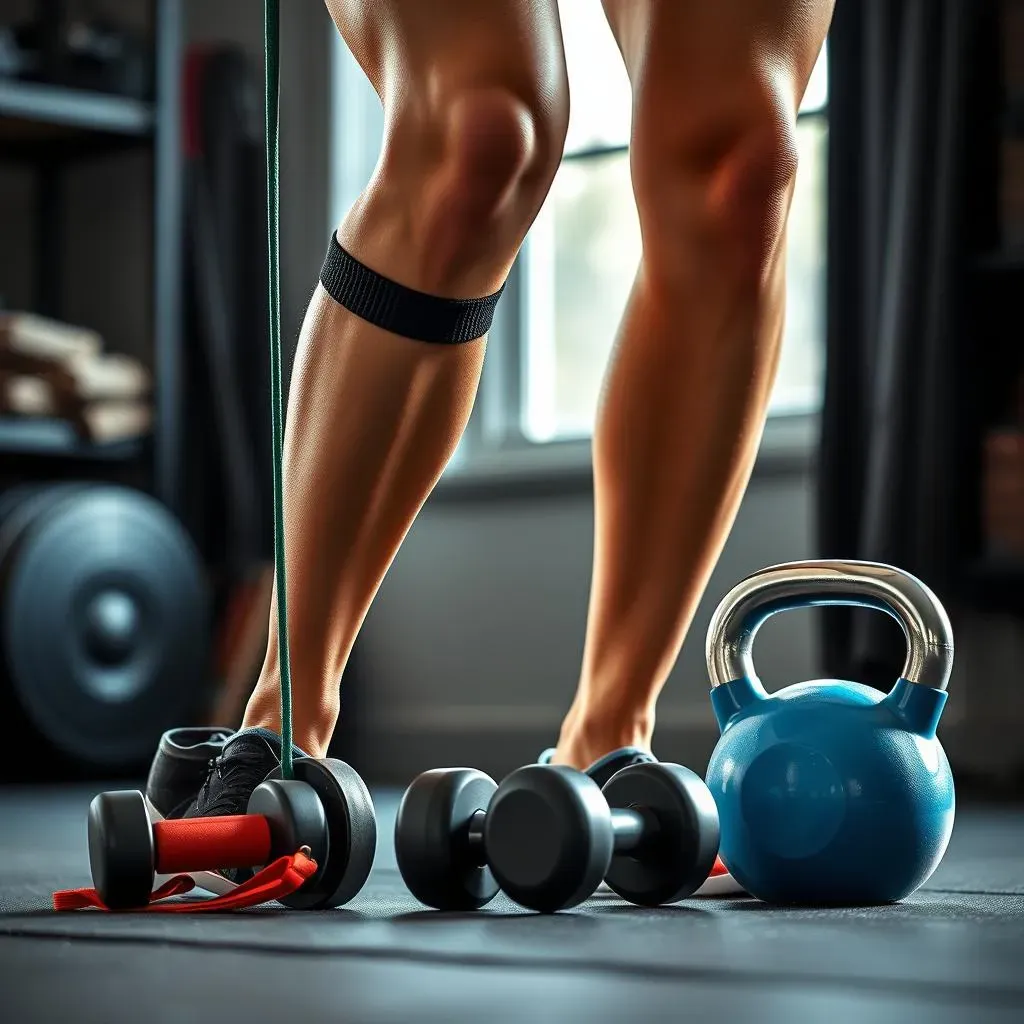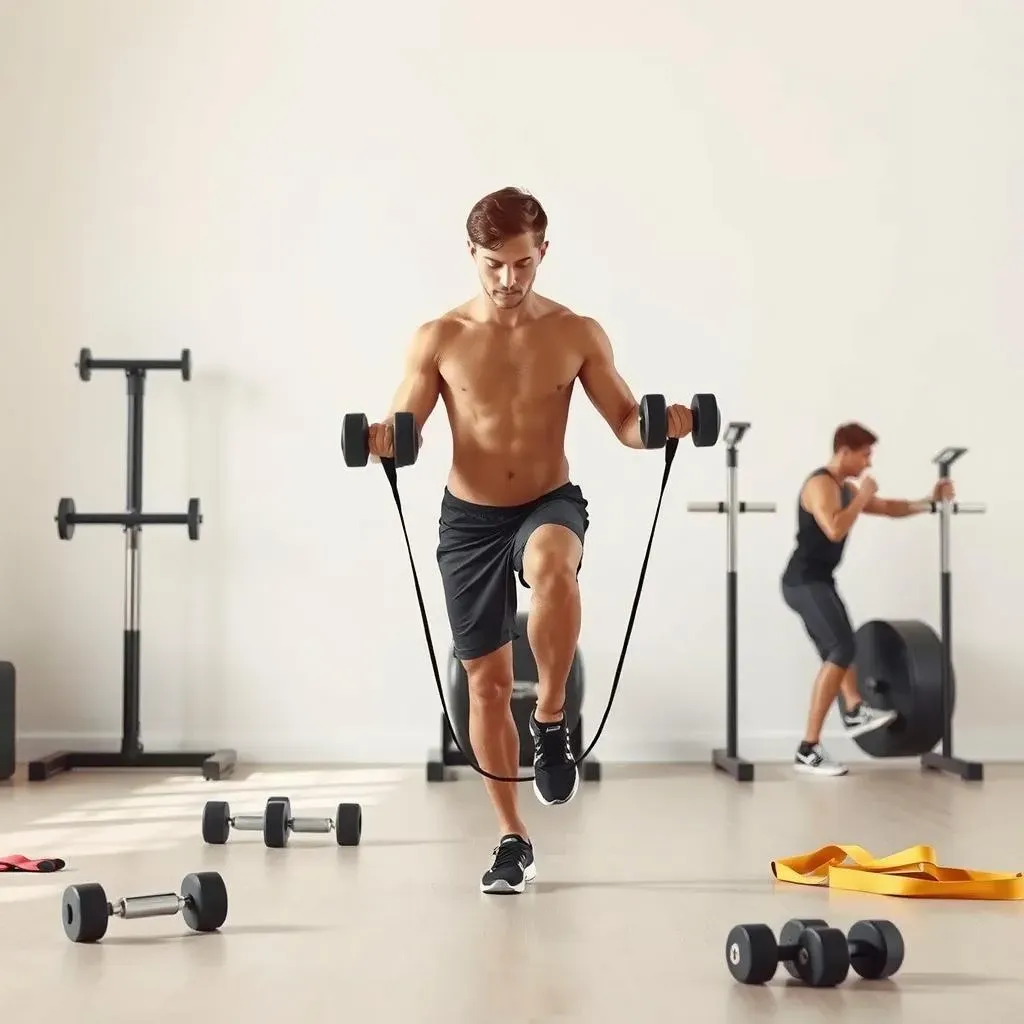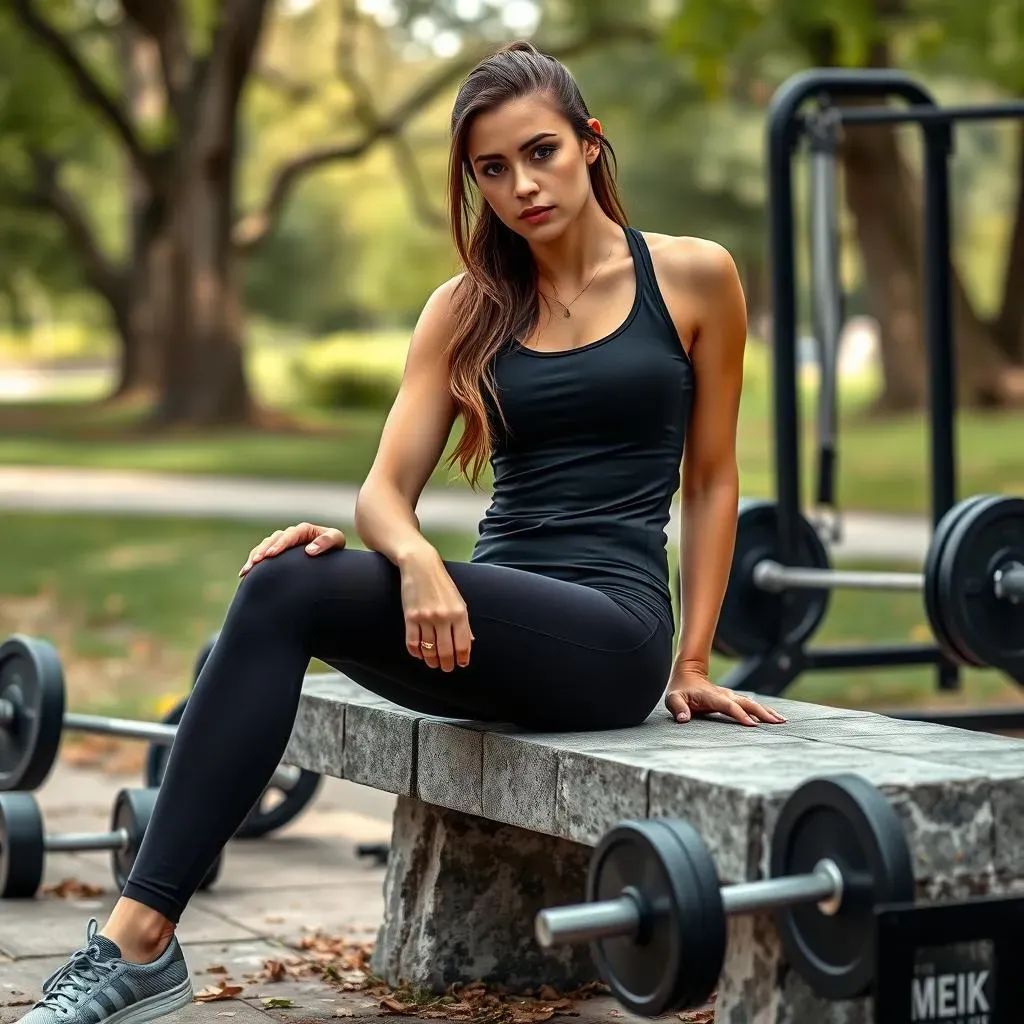Table of Contents
Tired of crowded gyms and skipping leg day? You're not alone. Many of us dream of powerful legs, but struggle to find the time or motivation to get to a gym. The good news? You can build incredible leg strength right at home, with the right at home gym equipment for legs. This article will guide you through everything you need to know, from understanding why leg training is so crucial, to selecting the best gear, and crafting a routine that fits your lifestyle. We'll cover the essential equipment, show you how to use it effectively, and give you tips to maximize your leg workouts. Get ready to transform your lower body, without ever leaving your house. Let's jump in and build those legs you've always wanted!
Why You Need At Home Gym Equipment for Legs
Why You Need At Home Gym Equipment for Legs
The Power of Leg Training
Let's be real, leg day is often the most skipped day at the gym. But guess what? Your legs are the foundation of your body, and neglecting them is like building a house on a shaky base. Strong legs aren't just about looking good; they're about boosting your overall strength, improving your balance, and making everyday activities easier. Think about carrying groceries, climbing stairs, or even just getting up from a chair – your legs are doing the heavy lifting. Having the right at home gym equipment for legs means you can work on this crucial part of your body anytime, no more excuses.
Plus, training your legs kicks your metabolism into high gear. Leg muscles are some of the biggest in your body, and working them out burns a ton of calories. It’s like having your own personal furnace, helping you torch fat even when you're not exercising. So, if you're serious about overall fitness, having the right gear at home to hit those legs is absolutely key. No more waiting for the squat rack at the gym, you can get it done on your own time.
Convenience and Consistency
One of the biggest wins with at home gym equipment for legs is the sheer convenience. No more trekking to the gym, fighting for machines, or working around someone else's schedule. You can squeeze in a leg workout whenever you have a free moment, whether it's 15 minutes in the morning or a longer session after work. This flexibility makes it way easier to stay consistent, and consistency is where the real gains happen. I know, I know, it's not as exciting as a new pair of shoes, but it's way more effective.
Think about it, how many times have you skipped leg day because of a busy schedule or bad weather? With your own setup at home, those excuses vanish. You have everything you need right there, ready to go. This consistency not only leads to better results, but it also builds a habit of regular exercise, which is a win for your overall health and well-being. It's about creating a sustainable routine, and having the right equipment at home makes that so much easier.
"The only bad workout is the one that didn't happen." - Someone Wise
Top At Home Gym Equipment for Legs: A Detailed Look
Top At Home Gym Equipment for Legs: A Detailed Look
Resistance Bands: Your Versatile Friend
Okay, let's talk basics. Resistance bands are like the Swiss Army knife of at home gym equipment for legs. They're cheap, portable, and can give you a killer workout. You can use them for squats, lunges, glute bridges, and even calf raises. The best part? They come in different resistance levels, so you can keep challenging yourself as you get stronger. I started with the lightest bands and now I can barely feel anything when I use them for warm up. These are a must for anyone starting out, or anyone looking to add a bit of extra intensity to their workouts. They take up almost no space and can be taken anywhere.
Don't underestimate these colorful strips of rubber! They’re not just for beginners; even advanced lifters use them to add resistance to their workouts or to improve their form. Try looping a band around your thighs during squats – you’ll feel the burn in your glutes like never before. Plus, they’re super easy to use. I’ve even used them while watching TV, which shows how convenient they are. They're not a replacement for heavier weights, but they are a great addition to your home gym.
Dumbbells: The Power of Free Weights
Next up are dumbbells. They are fantastic for building strength and muscle in your legs. Unlike machines, dumbbells force you to stabilize the weight, which engages more muscles. You can do squats, lunges, step-ups, and even Romanian deadlifts with them. Start with a manageable weight and increase it as you get stronger. I remember when I first started, I could barely do 5 reps with 10 pounds, now I can do 12 reps with 30 pounds each hand. It's a great feeling of progression. Having a set of dumbbells in your home gym opens up a lot of possibilities.
Another great thing about dumbbells is that they allow you to work each leg independently, which helps you identify and correct any imbalances you might have. You might find that one leg is slightly weaker than the other, and dumbbells allow you to address that. Plus, they don't take up a lot of space and can be easily stored when not in use. If you're serious about building strong legs, dumbbells should definitely be on your list of at home gym equipment for legs. Just make sure to start with a weight that feels challenging but manageable.
Equipment | Best For | Benefits |
|---|---|---|
Resistance Bands | Warm-ups, activation, extra resistance | Portable, cheap, versatile |
Dumbbells | Strength training, muscle building | Versatile, works stabilizing muscles, can be used for many exercises |
Adjustable Kettlebells: Compact and Mighty
Last but definitely not least, let’s talk about adjustable kettlebells. These are a fantastic option if you’re tight on space but want the benefits of heavier weight training. You can do squats, lunges, swings, and even goblet squats with a kettlebell. The adjustable feature means you can change the weight to match your fitness level, so you can keep progressing as you get stronger. I was hesitant to get one because I didn't know if I would use it, but I'm glad I did, it's now one of my favorite pieces of equipment.
Kettlebells are not just for squats and swings, you can also use them for exercises that target your glutes and hamstrings, like Romanian deadlifts or glute bridges. The unique shape of a kettlebell makes it great for dynamic movements that build functional strength. If you're looking to add some power and variety to your leg workouts, consider getting an adjustable kettlebell. It’s a compact, yet mighty tool that will help you get the most out of your at home gym equipment for legs. I find myself using it more and more every day.
Remember, the key is to start with what you have and gradually add more equipment as needed. Don't feel like you need to buy everything at once. Start with resistance bands, then maybe add some dumbbells, and then a kettlebell. The most important thing is to start and be consistent.
Creating a Leg Day Routine with Your At Home Gym Equipment
Creating a Leg Day Routine with Your At Home Gym Equipment 
Alright, so you've got your at home gym equipment for legs, now what? Let's talk about putting it all together. The key is to create a routine that's both challenging and sustainable. Don't try to do too much too soon, or you'll risk burnout. Start with 2-3 leg workouts per week, giving your muscles enough time to recover. Remember, consistency is more important than intensity in the beginning. I like to think of it like planting a seed – you wouldn't expect a tree to grow overnight, right? The same goes for building strong legs.
A good routine should hit all the major muscle groups in your legs: quads, hamstrings, glutes, and calves. You can achieve this by mixing different exercises. For example, you can start with squats to target your quads and glutes, move on to lunges to work on balance and stability, add some hamstring curls with resistance bands, and finish with calf raises. This variety will ensure that you are developing well-rounded strength and not just focusing on one area. Don't be afraid to experiment and find what works best for you. There are no hard rules, it's just about finding what feels good.
"It's not about perfect. It's about effort. And when you bring that effort every single day, that's where transformation happens." - Jillian Michaels
Let’s break down a sample routine, shall we? We'll use the equipment we talked about earlier. Start with a warm-up, like some light cardio and dynamic stretches. Then, do three sets of 10-12 reps of squats, using either your dumbbells or your resistance bands for extra resistance. Next up are lunges – again, three sets of 10-12 reps per leg. After that, try some Romanian deadlifts with your dumbbells or kettlebell, focusing on proper form. Finish with some calf raises, three sets of 15-20 reps, and you're done. Don't forget to cool down with some static stretches. This routine is just a starting point, feel free to adjust it to fit your fitness level and goals.
Remember to listen to your body. If something feels painful, stop. It's better to rest and recover than to push through and risk injury. Also, don't be afraid to take rest days. Your muscles grow when you're resting, not when you're working out. I usually take 1-2 rest days between leg workouts. I know it's hard when you are motivated, but it's important. And hey, if you're feeling adventurous, try mixing up your routine each week. You can add new exercises, increase the weight, or change the rep range. Variety is the spice of life, and it also keeps your muscles guessing.
Exercise | Sets | Reps | Equipment |
|---|---|---|---|
Squats | 3 | 10-12 | Dumbbells or Resistance Bands |
Lunges | 3 | 10-12 per leg | Dumbbells or Resistance Bands |
Romanian Deadlifts | 3 | 10-12 | Dumbbells or Kettlebell |
Calf Raises | 3 | 15-20 | Bodyweight or Dumbbells |
Maximizing Your Leg Workout: Tips and Tricks for at Home Gym Equipment
Maximizing Your Leg Workout: Tips and Tricks for at Home Gym Equipment
Focus on Form Over Weight
Alright, let's get real for a second. It's tempting to grab the heaviest weights you can find and try to blast through your workout, but that's a recipe for disaster. When it comes to leg training, especially at home with your at home gym equipment for legs, your form is everything. If you're not doing the exercises correctly, you're not going to get the results you want, and you're more likely to get injured. So, before you start adding more weight, make sure you've got the basics down. It's better to do 10 reps with perfect form than 20 reps with sloppy form. Trust me on this, I've learned the hard way.
Think of your form as the foundation of your workout. If it's shaky, everything else will crumble. Watch videos, read articles, and even consider recording yourself to check your technique. Pay attention to your posture, your range of motion, and how your body is moving. It might feel slow at first, but it will pay off big time in the long run. Focus on squeezing the right muscles and controlling the movement throughout the exercise. It's about quality, not quantity. When you have the form down, you will feel the difference, and then you can slowly increase the weight.
Progressive Overload: The Key to Growth
Once you've nailed your form, it's time to talk about progressive overload. This fancy term just means gradually increasing the challenge over time. Your body adapts to exercise, so you need to keep pushing it to see results. You can do this by adding weight, increasing the reps, or even changing the exercises. I like to think of it as leveling up in a video game. You wouldn't keep fighting the same weak enemies forever, right? You need to find new challenges to keep growing. With your at home gym equipment for legs, there are many ways to do it.
Start small, and don't try to add too much weight too soon, but be consistent. Try adding a little bit more weight each week, or increase the reps by 1-2. You can also try doing different variations of the same exercise. For example, if you're doing squats, you can try doing single-leg squats or jump squats. The key is to keep your body guessing and to keep pushing yourself outside your comfort zone. This is how you build strength and muscle. It's not easy, but it's worth it. Remember to log your workouts so you can see your progress over time, seeing the numbers go up is a great motivator.
"The pain you feel today will be the strength you feel tomorrow." - Arnold Schwarzenegger
Mind-Muscle Connection: Feel the Burn
You know, it's not just about moving the weight; it's about feeling the muscles working. The mind-muscle connection is a real thing, and it's especially important when you're training your legs with your at home gym equipment for legs. When you're doing squats, focus on squeezing your quads and glutes. When you're doing hamstring curls, focus on feeling that stretch and contraction in your hamstrings. It's about being present and engaged in your workout. It's not just about going through the motions, it's about feeling the burn.
This connection also helps you ensure that you're using the correct muscles for the exercise. If you're just going through the motions, you might be compensating with other muscles, which means you’re not getting the full benefit of the exercise. Try closing your eyes and focusing on feeling the muscles working. It might sound a little woo-woo, but it works. The more you connect with your muscles, the more effective your workout will be. It's about making each rep count, not just going through the motions. This is how you take your workouts to the next level.
Listen to Your Body: Rest and Recovery
Okay, you’ve been working hard, pushing your limits, and feeling the burn, but here's a crucial reminder: your body needs rest and recovery. It's tempting to push yourself every day, but that's not sustainable. Your muscles need time to rebuild and repair themselves. Overtraining can lead to injuries, burnout, and a lack of progress. So, make sure you're getting enough sleep, eating a balanced diet, and taking rest days when you need them. It's not a sign of weakness, it's a sign of intelligence. Having the right at home gym equipment for legs is great, but it's just one part of the equation.
Listen to your body, if you're feeling sore, take a rest day. If you're feeling tired, get some sleep. Don't push yourself too hard, especially when you're just starting. It's a marathon, not a sprint. Also, don't forget to stretch. Stretching helps improve flexibility and reduce muscle soreness. It's a small thing, but it makes a big difference. The more you prioritize rest and recovery, the more you can push yourself when you are training. It's about finding the right balance. Remember, consistency and sustainability are the keys to long-term success.
Tip | Why it Matters |
|---|---|
Focus on Form | Prevents injuries, maximizes muscle activation |
Progressive Overload | Ensures continuous muscle growth |
Mind-Muscle Connection | Improves workout effectiveness |
Rest and Recovery | Allows muscles to rebuild, prevents burnout |
Wrapping Up Your At-Home Leg Journey
So, there you have it. Building powerful legs at home isn’t some far-off dream; it's totally achievable with the right knowledge and a little dedication. We've explored why leg training is so important, looked at some great at home gym equipment for legs, and even talked about how to put it all together into a solid routine. Remember, consistency is key. Don't expect to see massive changes overnight, but with regular effort, you'll be amazed at what you can accomplish in your own space. So, ditch the excuses, grab your equipment, and let's get those legs working!